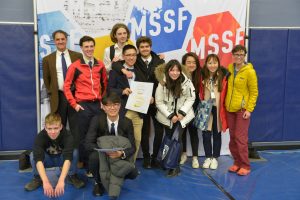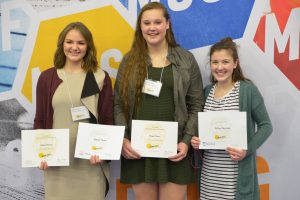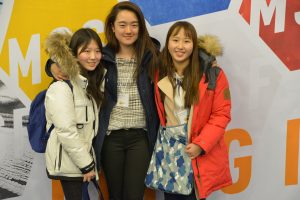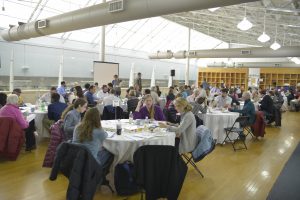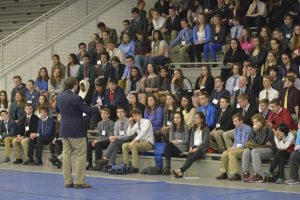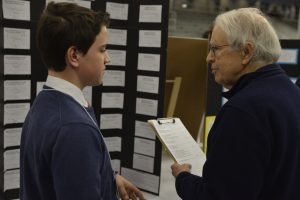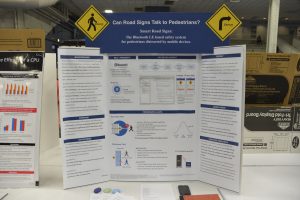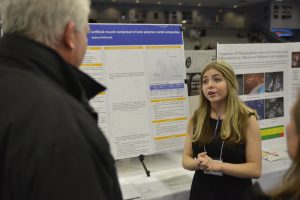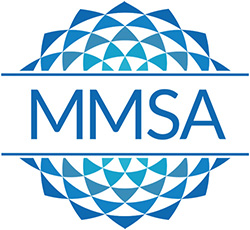
Winners will represent Maine at prestigious International Science Fair; scholarships from The University of Maine, College of the Atlantic, and the University of Southern Maine awarded to promising high school scientists and engineers.
200 students from 26 Maine schools competed for coveted state titles and approximately $840,000 in scholarships on Saturday, March 25 at the 71st annual Maine State Science Fair.
The event, which was organized by The Jackson Laboratory and the Reach Center @ Maine Mathematics and Science Alliance, and held at Colby College, enabled Maine high school students to demonstrate their original science research and engineering projects.
It’s really important that [the students] get a chance to see that science isn’t just about memorizing stuff in school,” explained Jan Mokros of MMSA, “but doing research; and this is their chance to show what they’ve got!”
We see so much talent year-after-year at this inspiring event that showcases Maine students’ accomplishments, and we’re honored to continue supporting the Maine State Science Fair,” said Tom Litwin, Vice President for Education at The Jackson Laboratory. “As a biomedical research institution, we’re particularly excited that all this talent is at our doorstep. We hope these bright young students feel encouraged to continue following their dreams through science and engineering and apply their talents within the State of Maine.”
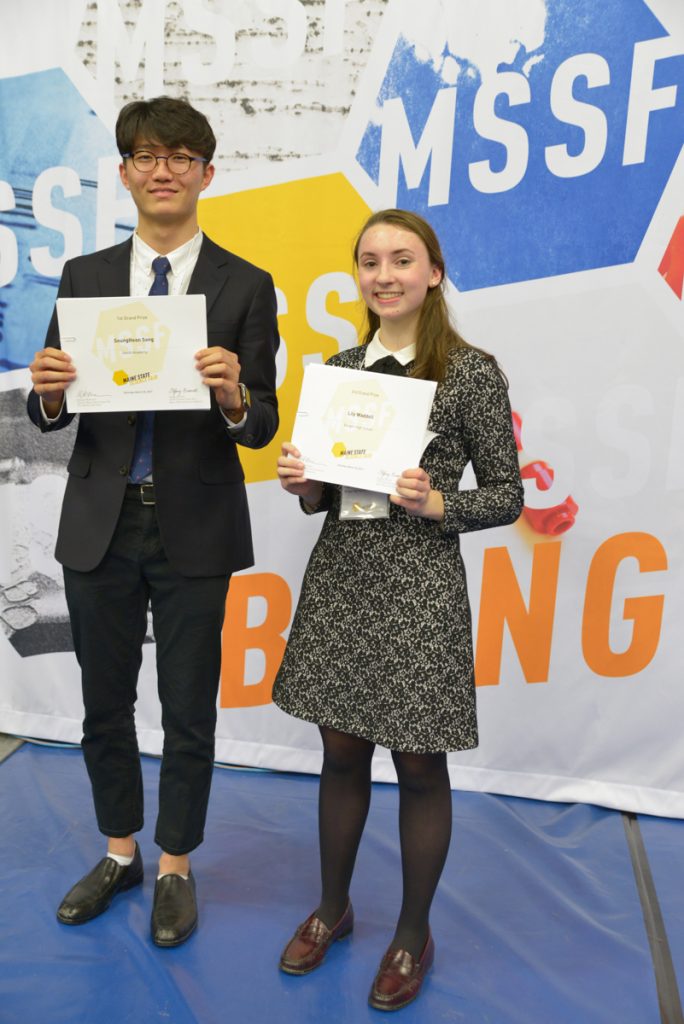
Taking top honors this year:
1st Grand Award
SeungHeon Song, Gould Academy
Smart road signs
2nd Grand Award
Sydney McDonald, Bangor High School
The future of prosthesis: The design & analysis of artificial muscle comprised of ionic-polymer metal composites
3rd Grand Award
Lily Waddell, Bangor High School
Developing an alternative treatment for luminal B breast cancer by targeting DNA repair mechanisms
These winners will represent the state at the Intel International Science and Engineering Fair in Los Angeles.
“The Maine State Science Fair showcases the talents of Maine’s most promising young minds,” says Jeffrey E. Hecker, Executive Vice President for Academic Affairs and Provost at the University of Maine. “As Maine’s public research university, the University of Maine partners to make such important engagement events possible, advocating for science, scholarship and creative achievement, and encouraging the researchers of tomorrow.”
In addition, several scholarships, totaling up to $840,000 from The University of Maine, College of the Atlantic, and the University of Southern Maine, were distributed to students demonstrating creativity, innovation, aptitude and great scientific potential.
The following students are invited to join the University of Maine Top Scholar program. The program includes a full-tuition scholarship renewable for four years, admission to the UMaine Honors College, match with a UMaine faculty mentor, and a research supply stipend:
University of Maine Top Scholar program recipients
- Mei Tian, Bangor High School
- David Rubin, Bangor High School
- Ashley Reynolds, Dexter Regional High School
- Kashmir Owen, Islesboro High School
- Maggie Nolan, Greely High School
- Chelsea Hoyt, Robert W. Traip Academy
- Elise Daub, Bangor High School
- Jacob Cote, Brewer High School
- Spencer Campbell, Bangor High School
- Hallie Macdougal, Watershed School
- Samuel Bonnevie, Greely High School
- Emma Bragdon, John Bapst Memorial High School
The following students received a $25,000 scholarship to College of the Atlantic, renewable for up to four years:
College of the Atlantic Scholarships
- Kashmir Owen, Islesboro High School
- Gina Vo, Bangor High School
The following students received a $4,000 Presidential Scholarship to the University of Southern Maine, renewable for up to four years:
Presidential Scholarship to the University of Southern Maine
- Gina Vo, Bangor High School
- Dalena Bennet, Westbrook High School
- Usira Ali, Portland High School
- Jacob Freudenberger, Nokomis Regional High School
- Isaac Sewell, Bangor High School
- Jacob Cote, Brewer High School
- Hannah Farrar, Dexter Regional High School
- Emily Elwell, Nokomis Regional High School
- Hallie Macdougal, Watershed School
- Moonhwe Jang, Gould Academy
- Corrigan Farnham, Greely High School
- Alexander Moreira, Old Town High School
“We are so excited to award these scholarships today,” said College of the Atlantic President Darron Collins. “I’m confident that our students will develop exceptional scientific ability and also, as human ecologists, understand the value of putting science in context. As important as science, technology, math, and engineering are, it’s also important that the people going into those fields have an interdisciplinary foundation to their approaches, and that is what we are striving to create at College of the Atlantic.”
Special Category Awards:
American Meteorological Society
- Alexander Moreira, Old Town High School, Heron Project
- Cam Doughty and Hannah Dunn, Bangor High School, The process of monitoring temperatures in the beehive
American Psychological Association
- Noah Robinson, Bangor High School, Testing cognitive bias in relation to the Big-5 personality type model, age, and gender
- Meghan Dye, Falmouth High School, Having your cake and eating it too: Maximizing the impact and accuracy of graphical visuals
ASM Materials Education Association
- Marina Mohawass, Bangor High School, The construction of biodegradable, disposable diapers from cellulose nanofibers
- Emma Payne, Bangor High School, Porous filtration membranes made from cellulose nanofibers
Association for Women Geoscientists
- Sarah Marcotte, Bangor High School, Exploration of relationships between metal deposition and vegetation composition in a Floridian sediment core
- Lauren Wallace, Washington Academy, Chandler River pollution study
GENIUS Olympiad
- Elyse Daub, Bangor High School, New England’s most valuable resource: Is increasing white pine (Pinus strobus) damage associated with a single fungal species or a community of fungi?
- Dwight Knightly, Bangor High School, Snowfall quality as a measurement of particulate matter
- Kaitlyn Dunham, Old Town High School, Do Polydora websteri prefer a certain temperature?
Institute of Food Technologists
- Ibrahim Saleh, Greely High School, The effect of glycine max heat exposure on the quantification of GMO events
Intel Excellence in Computer Science
- SeungHeon Song, Gould Academy, Smart road signs
Mu Alpha Theta Mathematics Award
- Jack Prior, Bangor High School, Applying O-Ring theory to the NBA and MLB
NASA Earth System Science Award
- Nick Baron, Old Town High School, Investigating habitat for a great blue heron in Penobscot County, Maine
NOAA: Taking the Pulse of the Planet Award
- David Rubin, Bangor High School, Modeling forest composition and water quality changes in Maine due to climate change
- Kashmir Owen, Islesboro Central School, The impacts of ocean acidification on marine calcifiers
Ricoh Sustainable Development Award
- Anthony Caccese, Jesse Karnes, and David Brown, Bangor High School, Designing a desk base containment system to improve the efficacy of a CPU heat-sink cooling system
- Gina Vo, Bangor High School, Can a cost-effective aquaponics system be produced using kale and convict cichlids?
Society for Science and the Public Award for Community Innovation
- Spencer Krebs, Aiden McDonough, and Colby Grimble, Bangor High School, The effects of compost produced by mealworms through the consumption of polystyrene
Stockholm Junior Water Prize
- Mei Tian, Bangor High School, Testing the effectiveness of mycorrhizae in the remediation of phosphorus from stormwater
The Jackson Laboratory Future Innovator Award
- Mack D’Angelo, Robert W. Traip Academy, Does learning style impact how you perform on optical illusion tests?
- John Wahlig, Falmouth High School, Headfirst
- John Connors and Jordyn Miller, Bangor High School, Studying the reactivation of biosand filters using microbiological testing
Reach Center Award from MMSA
- Usira Ali, Portland High School, Nanoparticles: the effects of shell size on optical memory
- Emma Hargreaves, Old Town High School, Reproductive cycles in Polydora websteri
- Ezra Smith, Lincoln Academy, A prototype of bone conducting headphones
- Alexis Allard, Nokomis Regional High School, S.C.O.B.Y sugar trials
- Nursultan Rosen, Brunswick High School, What are the best conditions for preventing bread mold?
U.S. Air Force
- Alexander Inman, Bangor High School, Behavioral analysis of a 6 meter HIAD structure and components
- Maggie Nolan, Greely High School, Development of rapid detection procedures for gamma-hydroxybutyrate derivative gamma-butyrolactone in varying liquid matrices
- Minjeong Kim, Gould Academy, Investigating the toxicity and mutagenicity of PHMG
U.S. Metric Association
- William Lehan and Alex Saros, Bangor High School, Acoustic analysis of various instruments, distortions, and tuning forks
Yale Science and Engineering Association
- Ban Shoukeir, Bangor High School, Extracting four major phenolic compounds from chaga mushroom
Category Awards
Animal Sciences
- 1st Award – Amara Ifeji, Bangor High School, Biodegradation and mineralization of polystyrene and polyethylene terephthalate (PET) by plastic-eating worms Tenebrio molitor and Zophobas morio
- 2nd Award – Chelsea Hoyt, Robert W Traip Academy, Biomechanics of jumping in equines: How jump height affects potential energy stored in the suspension apparatus
- 3rd Award – Kaitlyn Dunham, Old Town High School, Do Polydora websteri prefer a certain temperature?
Behavioral and Social Sciences
- 1st Award – Meghan Dye, Falmouth High School, Having your cake and eating it too: Maximizing the impact and accuracy of graphical visuals
- 2nd Award – Hannah Farrar, Dexter Regional High School, Training for peace
- 3rd Award – Megan Peach, Dexter Regional High School, The psychology of emojis
Behavioral and Social Sciences: Cognitive Psychology
- 1st Award – Noah Robinson, Bangor High School, Testing cognitive bias in relation to the Big-5 personality type model, age, and gender
- 2nd Award – Meghan Cantlin and Alison Noyes, Falmouth High School, Personality!
- 3rd Award – Amelia Ring, Falmouth High School, Peppermint’s impact on test taking speed
Biological Sciences and Engineering
- 1st Award – Sydney McDonald, Bangor High School, The future of prosthesis: The design & analysis of artificial muscle comprised of ionic-polymer metal composites
- 2nd Award – Jacob Cote, Brewer High School, Sequence analysis of rRNA and natural ribozymes
- 3rd Award – Robert Denegre, Taki Ishimura, and Nicholas Reznik, Mount Desert Island High School, Elucidating the underlying genetic pathways of beta-cell proliferation through quantitative trait locus analysis to shed new light in the pathogenesis of type 2 diabetes
Biomedical and Health Sciences
- 1st Award – Lily Waddell, Bangor High School, Developing an alternative treatment for luminal B breast cancer by targeting DNA repair mechanisms
- 2nd Award – Jacob Freudenberger, Nokomis Regional High School, The long term effects of a concussion
- 3rd Award – Christopher Allen, Eleanor Bridgers, and Nick Stanley, Mount Desert Island High School, Connecting circadian rhythm to type II diabetes using quantitative trait analysis
Chemistry and Materials
- 1st Award – Maggie Nolan, Greely High School, Development of rapid detection procedures for gamma-hydroxybutyrate derivative gamma-butyrolactone in varying liquid matrices
- 2nd Award – Marina Mohawass, Bangor High School, The construction of biodegradable, disposable diapers from cellulose nanofibers
- 3rd Award – Emma Payne, Bangor High School, Porous filtration membranes made from cellulose nanofibers
Computer Sciences
- 1st Award – SeungHeon Song, Gould Academy, Smart road signs
- 2nd Award – Spencer Campbell, Bangor High School, The creation of a masking program and a 3D triangulation program to assist in the optimization of a HIAD
- 3rd Award – David Brown, Anthony Caccese, and Jesse Karnes, Bangor High School, Designing a desk base containment system to improve the efficacy of a CPU heat-sink cooling system
Earth and Environmental Sciences: Energy, Climate, Weather
- 1st Award – Tyler Delargy, Bangor High School, A solution to the heat efficiency and environmental side-effects of oil boilers
- 2nd Award – David Rubin, Bangor High School, Modeling forest composition and water quality changes in Maine due to climate change
- 3rd Award – Dwight Knightly, Bangor High School, Snowfall quality as a measurement of particulate matter
Earth and Environmental Sciences: Water
- 1st Award – Mei Tian, Bangor High School, Testing the effectiveness of mycorrhizae in the remediation of phosphorus from stormwater
- 2nd Award – Naomi Moynihan, Bangor High School, How does road salt affect the Kenduskeag Stream?
- 3rd Award – Omar Alsamsam and Hassan Qureshi, Bangor High School, Storm water management research
Microbiology
- 1st Award – Corrigan Farnham, Greely High School, Modeling ultraviolet germicidal irradiation through Vibrio fischeri quorum sensing communication
- 2nd Award – Cecelia Ford, Nick Luce, and Lauren Richardson, Brewer High School, Does sound affect bacterial growth?
- 3rd Award – Alexis Allard, Nokomis Regional High School, S.C.O.B.Y sugar trials
Physics and Astronomy
- 1st Award – Samuel Bonnevie and Patrick Lyden, Greely High School, The effect of shoe sole tread design on the coefficient of friction
- 2nd Award – Ezra Smith, Lincoln Academy, A prototype of bone conducting headphones
- 3rd Award – Moonhwe Jang, Gould Academy, Considering the future of rocket nozzles
Plant Sciences
- 1st Award – Elyse Daub, Bangor High School, New England’s most valuable resource: Is increasing white pine (Pinus strobus) damage associated with a single fungal species or a community of fungi?
- 2nd Award – Hallie Macdougal, Watershed School, Oxygen production of phytoplankton
- 3rd Award – Ibrahim Saleh, Greely High School, The effect of glycine max heat exposure on the quantification of GMO events


